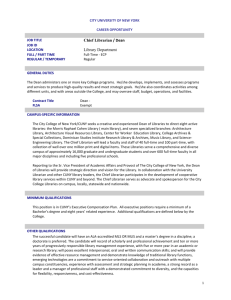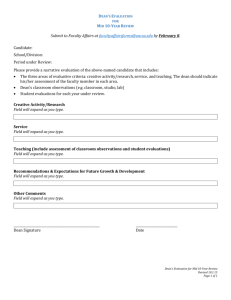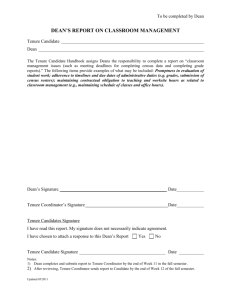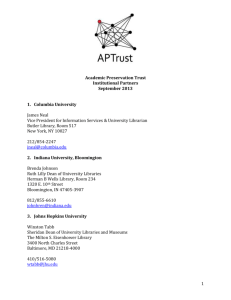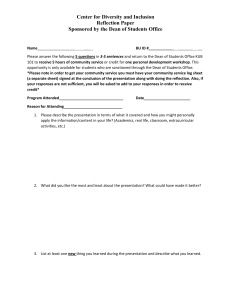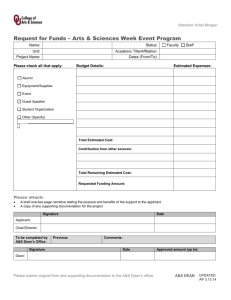iv. post-tenure review - Information for University Libraries Employees
advertisement
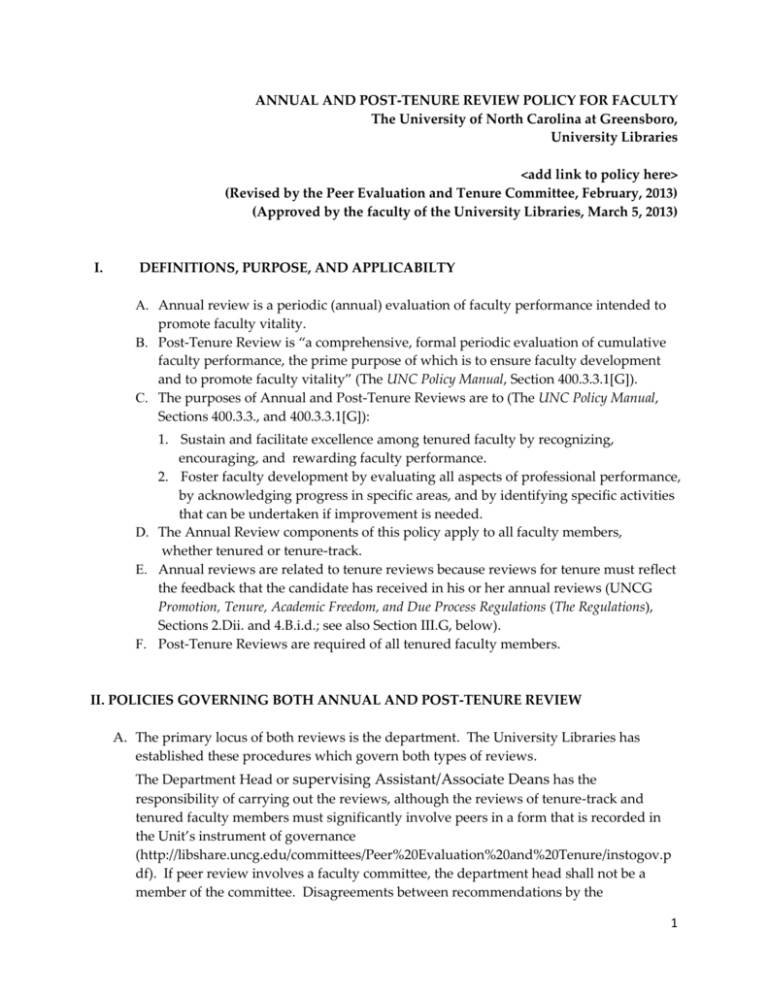
ANNUAL AND POST-TENURE REVIEW POLICY FOR FACULTY The University of North Carolina at Greensboro, University Libraries <add link to policy here> (Revised by the Peer Evaluation and Tenure Committee, February, 2013) (Approved by the faculty of the University Libraries, March 5, 2013) I. DEFINITIONS, PURPOSE, AND APPLICABILTY A. Annual review is a periodic (annual) evaluation of faculty performance intended to promote faculty vitality. B. Post-Tenure Review is “a comprehensive, formal periodic evaluation of cumulative faculty performance, the prime purpose of which is to ensure faculty development and to promote faculty vitality” (The UNC Policy Manual, Section 400.3.3.1[G]). C. The purposes of Annual and Post-Tenure Reviews are to (The UNC Policy Manual, Sections 400.3.3., and 400.3.3.1[G]): 1. Sustain and facilitate excellence among tenured faculty by recognizing, encouraging, and rewarding faculty performance. 2. Foster faculty development by evaluating all aspects of professional performance, by acknowledging progress in specific areas, and by identifying specific activities that can be undertaken if improvement is needed. D. The Annual Review components of this policy apply to all faculty members, whether tenured or tenure-track. E. Annual reviews are related to tenure reviews because reviews for tenure must reflect the feedback that the candidate has received in his or her annual reviews (UNCG Promotion, Tenure, Academic Freedom, and Due Process Regulations (The Regulations), Sections 2.Dii. and 4.B.i.d.; see also Section III.G, below). F. Post-Tenure Reviews are required of all tenured faculty members. II. POLICIES GOVERNING BOTH ANNUAL AND POST-TENURE REVIEW A. The primary locus of both reviews is the department. The University Libraries has established these procedures which govern both types of reviews. The Department Head or supervising Assistant/Associate Deans has the responsibility of carrying out the reviews, although the reviews of tenure-track and tenured faculty members must significantly involve peers in a form that is recorded in the Unit’s instrument of governance (http://libshare.uncg.edu/committees/Peer%20Evaluation%20and%20Tenure/instogov.p df). If peer review involves a faculty committee, the department head shall not be a member of the committee. Disagreements between recommendations by the 1 department head and the faculty member’s peers will be resolved by the dean, so that the faculty member receives a single rating. See below (Attachments 1-3) for procedures describing the conduct of peer review for both untenured and tenured faculty. B. Reviews of department heads will be conducted by their dean or assistant/associate dean, and reviews of the deans by the provost. The provost will establish the procedures for these reviews, which must be in general agreement with the policies established here. C. The responsibility for developing criteria for the evaluation of faculty performance rests with the University Libraries, but the criteria for the review of tenure-track and tenured faculty is based on those established in the University Wide Evaluation Guidelines for Promotions and Tenure (the Guidelines). The “Criteria for Merit Evaluation and Tenure for Librarians at the University Libraries” (currently under revision) will be used for evaluation at all levels in the Libraries. D. The faculty member being reviewed must receive written feedback as part of his or her review, and must be given an opportunity to respond formally to the review in writing. This response is attached to the review and becomes a formal part of the review. E. The reviews, including the faculty member’s response (if any), must be completed by the end of the fiscal year in which they are scheduled. F. All Annual and Post-Tenure Review Policies must respect the basic principles of academic freedom and may not abrogate, in any way, the criteria and procedures for due process and for dismissal or other disciplinary action established in accordance with Chapter VI of the Code of the University of North Carolina. III. ANNUAL REVIEW POLICIES A. The UNCG Annual Review Report Form, as modified by the University Libraries, must be used for all tenured and tenure-track faculty members. B. The University Libraries Annual Review Report Form divides the “Satisfactory” category into the evaluative sub-categories “marginally satisfactory, good, very good, and exemplary.” C. In addition to the summary information provided on the University Libraries Annual Review Report Form, it is incumbent on each department head to provide, to faculty members who have not yet been tenured, a clear indication of their progress towards promotion and/or tenure. This feedback must be informed by input from tenured faculty members, and must be consistent with the policies set down in Section 2 of the UNCG Promotion, Tenure, Academic Freedom, and Due Process Regulations, the evaluation criteria in the University Wide Evaluation Guidelines for Promotions and Tenure, and the Criteria for Merit Evaluation and Tenure for Librarians at the University Libraries 2 D. Prior to departmental review and completion of the University Libraries Annual Review Report Form, faculty members must supply a record of their annual accomplishments, which is produced after all relevant information is submitted in SEDONA, and is posted to Blackboard according to the ALFA and Annual Review Planning Calendar. The ALFA may include a written self-evaluation of the faculty member’s statement of accomplishments during the year. See Attachment 2 for detailed procedures relating to Annual Review. E. Annual feedback from the department head to tenured or tenure track faculty members will include a completed University Libraries Annual Review Report Form, written feedback on the year's achievements, and a written summary of input from peer reviews, including a summary of peer ratings. It may also include recommendations for rewards or improvement, as appropriate. F. Annual Reviews should provide a means of recognizing, encouraging, and rewarding faculty performance by means of merit pay increases, when funds are available for this purpose. G. The Annual Review Report Forms must be included in all tenure portfolios, for all years under consideration. The written feedback from each year (section III.E above) will be included as part of the tenure portfolio, and must be retained in the departmental offices so that it can be reviewed upon request, by the University Promotion and Tenure Committee. IV. POST-TENURE REVIEW A. The cumulative Post-Tenure Review summarizes the annual reports of a tenured faculty member’s work, and includes a summary evaluation of all aspects of his or her professional performance relative to the mission of the department, unit and institution. B. Post-Tenure Review shall take place no less frequently than every five years following the conferral of tenure. C. Peers must be involved in the Post-Tenure Review process. The faculty member being reviewed may not select members of the post-tenure review committee. The members of the University Libraries Peer Evaluation and Tenure (PE&T) Committee shall serve as the Post-Tenure Review Committee. The department head or supervising Assistant/Associate Dean has the responsibility of initiating the reviews. If the supervisor of the faculty member being reviewed is a member of the PE&T Committee, he or she may not contribute to this phase of peer evaluation. See Attachment 3 for detailed procedures describing the Post-Tenure Review process. D. Because Post-Tenure Review is a cumulative summary of the performance reported in faculty member’s annual reviews, he or she will not be required to provide additional documentation of his or her accomplishments, other than an up-to-date Curriculum Vitae. 3 E. Appropriate sections of the University Libraries Post-Tenure Review Report Form must be completed by the department head or supervising Assistant/Associate Dean, and the PE&T Committee, and be given to the Dean of the University Libraries. F. Because Post-Tenure Review must reward excellence, the Post-Tenure Review procedures designed by the units must provide a mechanism for recognizing excellent performance. G. Post-Tenure Reviews may reward performance by means of special, non-monetary, recognition such as: 1. Nomination for awards 2. Research leaves 3. Revisions of work load H. Unsatisfactory Post-Tenure Review. An Unsatisfactory cumulative review may only occur, but is not required, if there have been at least two unsatisfactory annual reviews in the current post-tenure review cycle. In cases of an unsatisfactory cumulative Post-Tenure Review, the following procedures must be followed: 1. The department head shall prepare and sign a statement declaring that the faculty member has received an unsatisfactory Post-Tenure Review. This statement must include a recital of the faculty member’s primary responsibilities and a specific description of his or her shortcomings as they relate to these duties. The statement must document the reasons why the faculty member has been given an unsatisfactory Post-Tenure review, with reference to specific failings noted in the faculty member’s annual reviews. Each of the relevant areas of performance must be addressed. A copy of this statement, along with copies of the faculty member’s last five annual reviews, and the materials submitted as part of their post-tenure review shall be delivered to the faculty member, and the dean. 2. The department head must, in consultation with the dean and the individual faculty member, develop a plan for the improvement of the faculty member’s performance, and a time line and benchmarks for improvement. The total time allowed for demonstrated improvement (as specified in the improvement plan) may not be less than two years. The resources necessary for the successful implementation of the improvement plan must be clearly stated in the plan, and must be made available to the faculty member during the improvement period. If the faculty member’s duties are modified as part of the improvement plan, then the plan should indicate this and take into account the new allocation. The plan must include a written statement of the consequences should improvement not occur within the designated time. If agreement between all parties is reached, the plan will be signed by all three parties. If, following the consultation specified above, the dean determines that agreement cannot be reached, the dean, with the approval of the provost, will sign the improvement plan. A copy of the improvement plan will be delivered to the faculty member 4 and his or her department head, and will become a permanent part of his or her personnel file. 3. Progress meetings with the department head must occur on at least a semiannual basis during the improvement period. 4. If a faculty member fails to meet the designated levels of improvement by the conclusion of the improvement period specified in the plan, then the department head may recommend that the faculty member be subjected to disciplinary action or discharged, as established in the UNC Policy Manual, Sections 400.3.3 and 400.3.3.1[G], and Section 603 of The Code of the UNC System. 5. If the department head recommends that the faculty member be discharged or subjected to other disciplinary action as established in Section 603 of The Code, then the following process of review shall be followed. a. The head’s recommendation shall be reviewed by a committee consisting of tenured faculty in his or her Department, and a recommendation to accept or reject the head’s suggested course of action prepared. i) A minimum of three tenured faculty members are normally necessary to assure adequate review. In cases where the dean believes there are too few tenured faculty in the candidate’s department, the dean will consult with the department head and the candidate on the constitution of the committee. If agreement between these parties is reached, a memorandum of agreement signed by all parties will specify the composition of the review committee. If, following the consultation specified above, the dean determines that agreement cannot be reached, the dean, with the approval of the provost, will specify the composition of the committee. It is the dean's responsibility to ensure that the committee is constituted so as to ensure a fair and independent peer assessment of the candidate's record. ii) Both the faculty member and department head may provide additional documentary evidence to this committee. The committee may also recommend modification of the disciplinary action suggested by the head. b. Both the head’s and the committee’s reports will be forward to the University Libraries Peer Evaluation and Tenure (PE&T) Committee, who will recommend for or against the recommended course of action to the dean. The committee may also recommend modification of the disciplinary action suggested by the head. c. The dean will review the recommended course(s) of action suggested by the head, the departmental committee and the PE&T Committee, and prepare a recommendation to the University Committee on Promotion and Tenure. The dean may recommend modification of the disciplinary action suggested by the head. d. The University Committee on Promotions and Tenure will review the dean’s suggested action and recommend for or against this action to the 5 provost. The committee may also recommend modification of the disciplinary action suggested by the dean. e. The provost will review the lower-level reviews and make a final recommendation to the chancellor. The provost may suggest modifications to the disciplinary action. f. Except for the grievance procedures established under Sections 603 of The Code of the University of North Carolina, the decision of the Chancellor is final. g. The University has the burden of proof in justifying the recommendation in question. The standard of proof to be used throughout the stages of this review is that of clear and convincing evidence (which is the same as the greater preponderance of the evidence). h. The recommendations at each level of review shall be forwarded, together with all of the documentary evidence and all of the prior recommendations, to the next level of review. V. Appeals A. Faculty members who receive an unfavorable Annual or Post-Tenure Review may appeal that review and/or the improvement plan to the Faculty Grievance Committee, according to the procedures of that committee. B. Faculty members who are the subject of disciplinary action, or dismissal, by the Chancellor may appeal this decision to the Due Process Committee according to the policies laid out in Section 603 of The Code of the University of North Carolina, as reflected in the Promotion, Tenure, Academic Freedom, and Due Process Regulations of the University of North Carolina at Greensboro, and in the operating policies of that committee. The above regulations are modeled on the Annual and Post-Tenure Review Policy for Faculty UNCG (http://provost.uncg.edu/documents/personnel/posttenurereview.pdf) Revised by the PE&T Committee, Nov. 2012-Feb. 2013. 6 The following three attachments describe procedures to be used in the Annual Review and Post-Tenure Review processes. Attachment 1. Procedures for conducting peer review for both tenured and untenured librarians. A. The PE&T Committee will prepare a spreadsheet for peer review in which all tenured and untenured librarians are listed along with the tenured librarians who are responsible for reviewing each librarian. To the degree possible, review will be informed by faculty in the same department. B. Mandatory reviews. Each untenured librarian will be reviewed by five tenured librarians; each tenured librarian will be reviewed by three tenured librarians. Reviews will be completed using the University Libraries Peer Performance Review form (see Attachment 2, section C). C. Completed forms are sent to the Department Head or supervising Assistant/Associate Dean, who will maintain a copy in the librarian’s file. D. Department Heads or supervising Assistant/Associate Deans are responsible for summarizing the responses and ratings of all peer reviews received and including this information in the librarian’s annual review (see III.E in policy document). E. Invited reviews. In addition to the mandatory reviews, the Dean will invite all librarians (tenured and untenured) to submit a review for any librarian(s) (tenured or untenured) using the University Libraries Peer Performance Review form or in the form of a letter. These invited reviews are sent to the Department Head or supervising Assistant/Associate Dean. F. The Department Head or supervising Assistant/Associate Dean completes sections I-III of the University Libraries Annual Review Report Form and signs section V of the form. He or she also keeps the master copy of the form on which signatures are recorded. G. Each librarian who provides a mandatory review must sign section V of the University Libraries Annual Review Report Form. Those who provide invited reviews do not sign the University Libraries Annual Review Report Form. H. The Dean provides an overall rating of each tenured or untenured librarian and signs section V of the University Libraries Annual Review Report Form. I. After all reviews are completed, the Department Head or supervising Assistant/Associate Deans meets with the librarian under review and discusses the review. The candidate signs section V of the University Libraries Annual Review Report Form and may submit a response, if he or she wishes to. 7 Attachment 2: Procedures for conducting annual reviews for all library faculty (The calendar, review forms, and review policies are available on http://libshare1.uncg.edu/committees/Pages/PETC.aspx.) A. Planning Calendar The Peer Evaluation and Tenure (PE&T) Committee, in consultation with the Dean of University Libraries, develops the ALFA (Annual Library Faculty Accomplishments) and Annual Review Planning Calendar in January. It includes due dates for ALFAs, peer reviews, and annual reviews. It is distributed to all tenured and tenure-track librarians. B. Annual Library Faculty Accomplishments (ALFA) 1. 2. 3. 4. 5. 6. C. All tenure-track and tenured librarians complete an ALFA, a self-report listing goals and accomplishments, based on the time frame established by the Dean (normally fiscal year, July 1st to June 30th). Sedona is the reporting tool used to generate the ALFA. Section I is a copy of the goals listed in Section VI of the previous year’s report. Section II is a descriptive list of accomplishments for the year. Sections III-V are formatted by the Sedona system. Section VI, goals for the coming year, should be completed with the understanding that these may change after consultation with the supervisor. Sections I-V of the ALFAs are sent as a Word document to the Human Resources Librarian who will convert the files to PDF and post the files on Blackboard. Peer Performance Reviews (PPR) 1. 2. 3. 4. All untenured and tenure-track librarians will be reviewed using the procedures described in Attachment 1 to the Annual and Post-Tenure Review Policy for Faculty. In addition to the mandatory reviews, any librarian not part of the mandatory review may review any other librarian. Non-mandatory reviews may use the Peer Performance Review form on the website or submit a letter. Before writing any reviews, librarians are expected to examine the ALFAs that are posted in Blackboard (path: Groups, ALFAs, file exchange). Reviews should be based on actual experience with the librarian, not on hearsay. Negative comments should be accompanied by suggestions on means of improvement. 8 5. D. Completed review forms and letters are given to the Dept. Head or supervising Assistant/Associate Dean. Annual Performance Review by the Supervisor 1. 2. 3. 4. 5. 6. 7. Based upon the University calendar and in conjunction with the Dean of University Libraries, the PE&T Committee determines the date by which meetings with the supervisor must be completed and the written annual reviews submitted to the Dean of University Libraries (normally near the end of June) The supervisor must meet privately with each librarian by the date specified on the Planning Calendar. Prior to this meeting each librarian should provide his/her supervisor with a copy of the tentative goals specified in Section VI of the ALFA. Prior to the meeting the supervisor should read any Peer Performance Reviews that are available. Based on his or her knowledge of the librarian, on the contents of the ALFA, and on any PPRs, the supervisor prepares a written evaluation of the librarian which must include a summation of any PPRs. Also, the supervisor assigns the librarian one of five ratings as specified in Section II of the University Libraries Annual Review Report Form. Both the written review and the rating are provided to the librarian prior to the meeting. The supervisor meets with the librarian to discuss the written review, to convey any strengths and weaknesses noted in the PPRs, to suggest ways to maximize strengths and reduce weaknesses for the next annual review, and to finalize goals for the coming year. As an additional step for any meeting with an untenured librarian, the supervisor points out areas of strength or weakness in regard to the three areas that will be evaluated for reappointment and tenure, i.e. librarianship, research and creative activities, and service. In the course of the meeting both the supervisor and the librarian may agree to make changes to the written review. The librarian should read and initial each page of the final copy of the review and both parties should sign and date the last page of the review, the goals statement, and the University Libraries Annual Review Report Form. The written review, the University Libraries Annual Review Report Form, the ALFA, PPRs and any letters are submitted to the Dean. All paperwork is filed in the personnel folders by the Human Resources Librarian. 9 Attachment 3. Post Tenure Review Procedures A. Preparation of Post-Tenure Review Materials (Candidate and Department Head) 1. The candidate provides a current CV to his or her department head. 2. The candidate’s Dept. Head or supervising Assistant/Associate Dean prepares a cumulative review that incorporates annual reviews for the year in which the cumulative review takes place plus the four previous years. The cumulative review should include a summary evaluation of all aspects of the professional performance of a faculty member in the areas of teaching, research and creative activity, and service. It should also include a summary of comments from peer reviews over the five year evaluation period. If faculty responsibilities are primarily only in one or two of the areas listed above, post-tenure review and the resulting recommendations should take this allocation of responsibilities into account. The cumulative review should include the category the candidate was placed in for each year (unsatisfactory, marginally satisfactory, good, very good, exemplary) for each of the 5 years. 3. The candidate’s department head or supervisor completes sections I and II of the University Libraries Post-Tenure Review Report Form, gives an overall rating of satisfactory or unsatisfactory, includes his/her written evaluation described above, and signs the form. The department head posts the form, annual reviews, and ALFAs in Blackboard. 4. The candidate’s department head or supervisor notifies the chair of the PE&T Committee that the materials are in Blackboard. B. Role of the Peer Evaluation and Tenure Committee 1. Establishes a calendar for annual and post-tenure reviews. 2. If there are fewer than five members of the committee eligible to review the candidate (for example, if the candidate, his or her department head, or both are members of the PE&T Committee), the PE&T Committee will appoint one or two additional members to bring the total number of reviewers to five. 3. The PE&T Committee, thus constituted, reviews the candidate’s five ALFAs, the supervisor’s five year evaluation (including the categories the candidate was placed in for the five-year period), the candidate’s CV, and letters or peer reviews solicited by the dean. 4. The committee prepares a summary of its discussion in the form of a written evaluation of the candidate. 5. Using section III of the University Libraries Post-Tenure Review Report Form, the committee records its decision by placing the candidate in the category of Satisfactory or Unsatisfactory, and attaches its written evaluation. All members of the committee sign Section V of the form. 10 6. Copies of letters expressing dissenting views by members of the committee must be included with the University Libraries Post-Tenure Review Report Form if the decision is not unanimous. 7. The Chair notifies the Dean that the revised University Libraries Post-Tenure Review Report Form and any letters expressing dissenting views are available for review. 8. Copies of the Post-Tenure Review Report Form will be given to the candidate and candidate’s supervisor. C. Role of the Dean 1. The Dean invites members of the tenured faculty to submit letters or peer review forms regarding the post-tenure review candidate(s). 2. The Dean prepares her own written evaluation and overall rating after receiving materials/notification from the chair of the PE&T Committee. 3. The Dean fills out section IV of the University Libraries Post-Tenure Review Report Form, and signs section V. 4. Disagreements between recommendations by the department head and the faculty member’s peers (PE&T Committee) will be resolved by the dean, so that the faculty member receives a single rating. 5. Copies of the evaluations (Dept. Head, PE&T Committee, and Dean), and the University Libraries Post-Tenure Review Report Form will be given to the candidate and candidate’s supervisor. 5. After all levels of review are completed, the candidate reviews all materials, signs the University Libraries Post-Tenure Review Report Form, and provides a response if he/she wishes. 7. The Dean sends her letter with vote totals, and the PE&T Committee’s summary evaluation to the Provost by final date on Provost’s calendar. 8. A copy of all materials are added to the librarian’s personnel file by the Human Resources Librarian. Prepared Nov. 2012-Feb. 2013 by PE&T Committee 11


